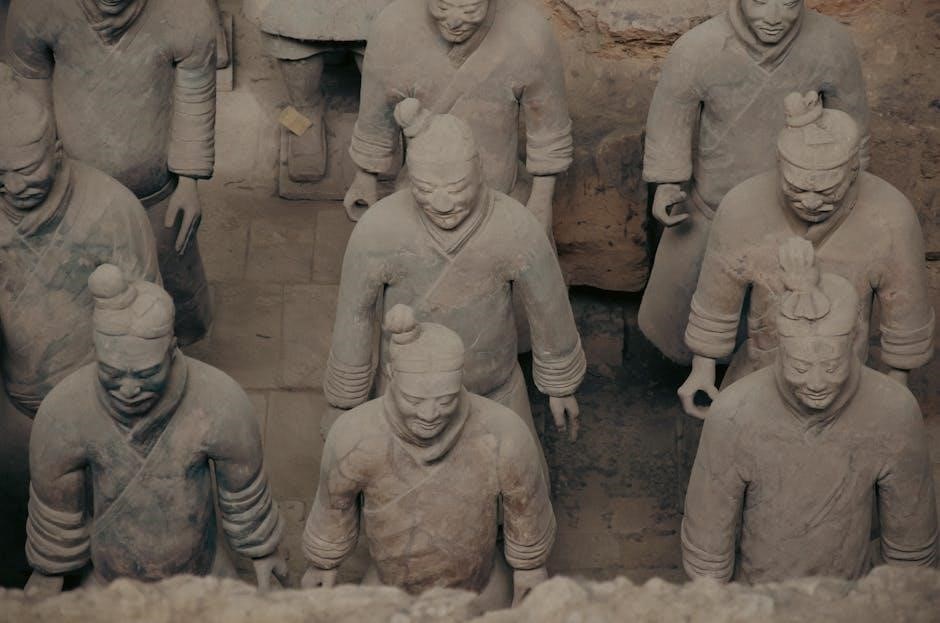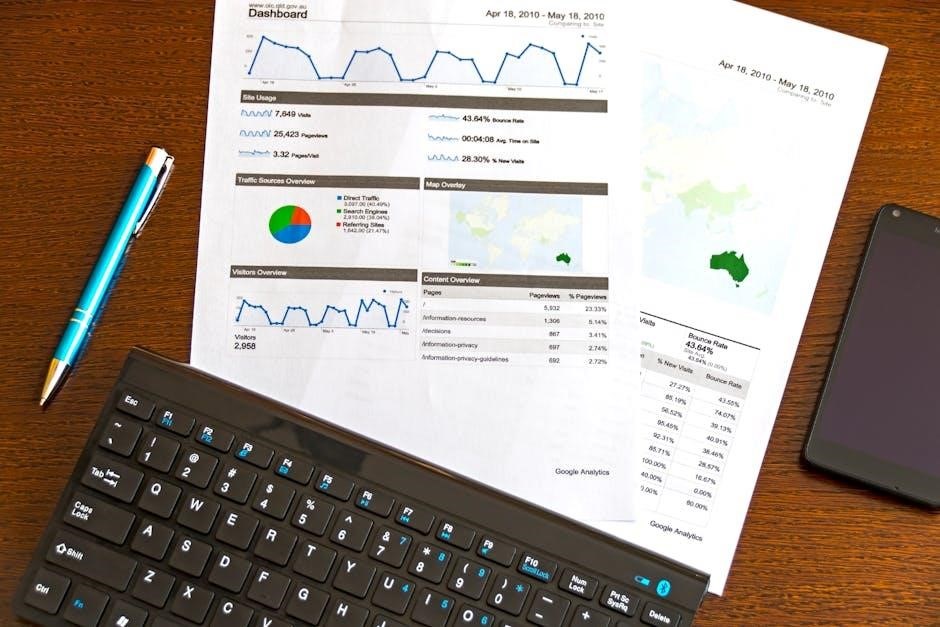Significant figures are essential in chemistry for ensuring accuracy and precision in measurements and calculations. They help scientists communicate the reliability of data, distinguishing precise values from estimates. Understanding significant figures is crucial for valid interpretations and reproducible results in scientific experiments and analyses.
1.1 Definition and Importance of Significant Figures
Significant figures are the digits in a measurement that contribute to its precision and accuracy. They represent the reliable and certain values obtained from an experiment or calculation. The importance of significant figures lies in their ability to communicate the quality of data without overrepresenting or underrepresenting its reliability. In chemistry, they ensure consistency in reporting measurements, helping scientists avoid misinformation. By adhering to rules for counting significant figures, researchers maintain clarity and reproducibility in their work. Proper use of significant figures also prevents errors in data interpretation, making them a cornerstone of scientific communication and reliable experimentation.
1.2 Role of Significant Figures in Scientific Measurements
Significant figures play a vital role in scientific measurements by indicating the precision and reliability of data. They help distinguish between measured and estimated values, ensuring that measurements are reported accurately without overconfidence. In experiments, significant figures guide the recording of data, as all digits, including zeros, must be considered according to specific rules. This consistency ensures that results are reproducible and comparable across different studies. By using significant figures, scientists can communicate the certainty of their measurements clearly, maintaining the integrity and transparency of their work. This practice is fundamental in chemistry and other sciences for upholding rigorous standards in research and experimentation.

Basic Rules of Significant Figures
- All non-zero digits are significant.
- Zeros between non-zero digits are significant.
- Zeros at the end of a number with a decimal point are significant.
- Zeros in measurements are significant, but not in definitions.
2.1 General Guidelines for Counting Significant Figures
Counting significant figures involves identifying all certain digits and the first uncertain digit in a measurement. Non-zero digits are always significant, while zeros may or may not be, depending on their position. Zeros between non-zero digits are significant, as they add precision. Trailing zeros in numbers with decimal points are also significant. Leading zeros, however, are never significant. For whole numbers without decimal points, trailing zeros are ambiguous and may not be considered significant unless specified. Understanding these guidelines ensures accurate representation of measured values, maintaining the integrity of scientific data and calculations.
2.2 Rules for Zeros in Significant Figures
Zeros in significant figures can be tricky but follow specific rules. Leading zeros are never significant, as they do not affect the measured value. Trailing zeros in numbers with decimal points are significant, while those without decimals are ambiguous. For example, 4.00 has three significant figures, but 400 may or may not, depending on context. Zeros between non-zero digits are always significant, as they add precision. Understanding these rules ensures accurate counting of significant figures, especially in complex measurements and calculations. Properly identifying significant zeros maintains data integrity and clarity in scientific communication.
2.3 Rules for Rounding Numbers
Rounding numbers is a critical skill in working with significant figures. The basic rule is to round to the desired number of significant figures by looking at the digit immediately following the last significant figure. If it is 5 or greater, the preceding digit is rounded up; if less than 5, it remains unchanged. For example, rounding 3.145 to two significant figures gives 3.1, while rounding 4.987 to three significant figures results in 4.99. This rule applies universally, whether dealing with small or large numbers. Proper rounding ensures that the final result reflects the precision of the original measurement without introducing misleading certainty.
Significant Figures in Measurements
Significant figures in measurements ensure accuracy and precision, reflecting the reliability of data. All digits, including zeros, are considered based on their position and context. Zeros between non-zero digits are always significant, while trailing zeros may or may not be, depending on the presence of a decimal point. Rounding numbers to the appropriate significant figures is essential for maintaining consistency in scientific communication. Properly applying these rules helps avoid overestimating or underestimating the precision of results. Understanding these principles is crucial for recording and interpreting measurements accurately in chemistry and related fields. This ensures that experimental data remains credible and reproducible.

3.1 Recording Measurements with Significant Figures
Recording measurements with significant figures requires careful attention to detail to ensure accuracy. All digits known with certainty, including zeros between non-zero digits, should be included. Zeros at the end of a number are significant if they come after a decimal point or are specifically indicated. For example, 100. has three significant figures, while 100 without a decimal point may have one, two, or three, depending on context. Measurements should never include more or fewer digits than justified by the precision of the instrument used. Properly recording significant figures helps maintain the integrity of experimental data and ensures reliable results in scientific investigations and reporting. This practice is fundamental to maintaining consistency in chemistry and related disciplines.
3.2 Certainty and Uncertainty in Measurements
Certainty in measurements refers to the digits known with precision, while uncertainty represents the degree of doubt. Significant figures help distinguish between the two, ensuring clarity in scientific communication. In a measurement, all digits are certain except the last one, which is an estimate. For example, in 45.6 cm, the “4,” “5,” and “6” are certain, while in 8.74 kg, the “8,” “7,” and “4” are certain. Understanding this balance is crucial for accurately interpreting and reporting experimental results. Properly identifying certainty and uncertainty ensures that measurements are reliable and reproducible, which is vital in chemistry and other scientific disciplines for maintaining data integrity and draws conclusions with confidence. This concept is fundamental to the validity of experimental outcomes and data analysis.
Significant Figures in Calculations
Significant figures guide the precision of calculated results, ensuring accuracy in operations like addition, subtraction, multiplication, and division. Rules dictate rounding to maintain consistency with input data precision, avoiding overreporting.
4.1 Addition and Subtraction Rules
In addition and subtraction, the result must align with the least precise measurement’s decimal places. For example, if one value has two decimal places and another has one, the answer should have one. This ensures consistency and avoids overreporting precision. When performing calculations, focus on the number of decimal places rather than significant figures. Trailing zeros in decimal numbers are significant, so they count toward the total. Always round the final answer to match the least precise measurement’s decimal places to maintain accuracy and reliability in scientific calculations and reporting.
4.2 Multiplication and Division Rules
In multiplication and division, the result must have the same number of significant figures as the least precise number used. For example, if one number has three sig figs and the other has two, the answer should have two. This ensures consistency in precision. When rounding, focus on the total number of significant figures, not decimal places. Trailing zeros in numbers with decimals are significant, so they count. Always apply this rule to maintain accuracy and avoid overreporting precision in calculations. Proper application of these rules is essential for reliable scientific reporting and data interpretation in chemistry and related fields.
4.3 Mixed Operations and Significant Figures
Mixed operations require careful handling to maintain the correct number of significant figures. Always perform multiplication and division before addition and subtraction. When combining operations, apply the rules step-by-step. For example, first multiply or divide to find an intermediate result, then round it to the appropriate number of significant figures before proceeding with addition or subtraction. Ensure each step adheres to the rules to avoid cumulative errors. Proper sequencing and rounding at each stage are crucial for accurate final answers. This method prevents overreporting precision and ensures consistency in complex calculations, making it a cornerstone of reliable scientific data processing and reporting in chemistry.

Significant Figures Worksheet with Answers
This worksheet provides comprehensive exercises and examples to practice significant figures in chemistry. It includes rules, guidelines, and step-by-step solutions for accurate problem-solving and mastery of the concept.

5.1 Basic Problems on Significant Figures
This section offers foundational exercises to master the basics of significant figures. Questions cover identifying significant digits, rounding numbers, and applying rules to simple calculations. Each problem is designed to reinforce understanding of key principles, ensuring a solid grasp of when and how to apply significant figures in various scenarios. Detailed solutions guide learners through correct methods, helping them build confidence in handling measurement precision and accuracy. These exercises are ideal for beginners or those needing a refresher on the fundamental aspects of significant figures in chemistry and scientific notation.
5.2 Intermediate Problems on Significant Figures
This section provides exercises that challenge learners to apply significant figure rules to more complex calculations. Problems involve multiplication and division, where the number of significant figures in the final answer matches the least precise measurement. Additionally, questions require rounding intermediate results appropriately without losing precision. Mixed operations, such as combining addition and subtraction with multiplication or division, are also included to simulate real-world scientific scenarios. Solutions are provided to guide learners through each step, ensuring clarity and understanding. These problems help build proficiency in handling multi-step calculations while maintaining accuracy and precision in scientific measurements and data analysis.
5.3 Advanced Problems on Significant Figures
This section is designed for learners who have mastered the basics and intermediate concepts of significant figures. It presents complex problems that involve multi-step calculations, mixed operations, and precise rounding techniques. These exercises require a deep understanding of significant figure rules, including handling zeros, decimal places, and uncertainty in measurements. Problems are tailored to resemble real-world scientific scenarios, emphasizing the practical application of significant figures in chemistry. Detailed solutions are provided to guide learners through intricate calculations and ensure accuracy. These advanced problems help learners refine their skills in maintaining precision and reliability in complex scientific computations and data interpretation.

Common Mistakes in Significant Figures
Common errors include miscounting zeros, ignoring rules for specific operations, and improper rounding. Students often overlook the significance of trailing zeros and decimal placement in measurements.
6.1 Miscounting Zeros and Decimal Places
Miscounting zeros and decimal places is a frequent mistake in handling significant figures. Many students struggle with identifying whether zeros in a number are significant or merely placeholders. For instance, zeros at the end of a number after a decimal point are significant, while those before the first non-zero digit are not. Additionally, trailing zeros in numbers without a decimal point can be ambiguous, leading to confusion. Misinterpreting these rules can result in incorrect reporting of significant figures, affecting the precision and credibility of scientific measurements and calculations. Proper training and practice are essential to avoid such errors.
6.2 Ignoring Rules for Specific Operations

Another common mistake is ignoring the specific rules for significant figures in different mathematical operations. For example, in addition and subtraction, the result should match the least precise measurement’s decimal places, while in multiplication and division, the result should have the same number of significant figures as the least precise operand. Many students overlook these distinctions, leading to incorrect rounding and improper reporting of significant figures. This can result in answers that are either overly precise or not precise enough, undermining the validity of the data. Consistent practice with worksheets and exercises is essential to master these operation-specific rules and avoid such errors.

Tips for Mastering Significant Figures
Mastering significant figures requires consistent practice and a clear understanding of their purpose. Regularly working through worksheets and applying rules in calculations strengthens proficiency and accuracy.
7.1 Understanding the Purpose of Significant Figures
Significant figures are crucial for conveying the precision of scientific measurements and calculations. They help distinguish between measured and estimated values, ensuring clarity and reliability in data communication. By mastering significant figures, scientists can accurately report their findings, maintaining consistency and reproducibility in experiments. This understanding is foundational for proper rounding, reducing errors, and interpreting results effectively. Worksheets and practice exercises are invaluable tools for reinforcing these concepts and ensuring proficiency in real-world applications.
7.2 Practicing with Worksheets and Exercises
Practicing with worksheets and exercises is an effective way to master significant figures. These tools provide hands-on experience with various scenarios, helping to identify patterns and build confidence. Worksheets often include problems ranging from basic to advanced, covering addition, subtraction, multiplication, division, and rounding. By solving these exercises, learners can refine their understanding of how significant figures apply to different operations. Examples include rounding numbers to a specific count of significant figures and determining the correct number of significant figures in measurements. Regular practice ensures consistency and accuracy, reinforcing the fundamental rules and reducing errors in scientific calculations and reporting.
Real-World Applications of Significant Figures
Significant figures are crucial in laboratory experiments, ensuring precision and reliability in measurements. They are vital in data analysis and reporting, maintaining consistency and reproducibility in scientific research.
8;1 Significance in Laboratory Experiments
Significant figures play a pivotal role in laboratory experiments, ensuring accuracy and reproducibility of results. They guide scientists in recording measurements precisely, avoiding overconfidence in data. By applying significant figures, researchers can determine the reliability of their findings and communicate the certainty of their measurements. This precision is crucial for maintaining consistency across experiments and ensuring that conclusions are valid and trustworthy. Proper use of significant figures also helps in identifying potential errors and improving experimental design. In chemistry labs, significant figures are integral to maintaining high standards of scientific integrity and reliability in data analysis and reporting.

8.2 Importance in Data Analysis and Reporting
Significant figures are vital in data analysis and reporting to ensure precision and clarity. They help scientists present data accurately, avoiding overconfidence in results. By adhering to significant figures, researchers maintain credibility and consistency in their findings. This practice prevents misinterpretation of data and enhances the reliability of scientific communication. Proper reporting also helps in identifying potential errors and ensures that conclusions are drawn from valid data. In chemistry, significant figures are essential for maintaining high standards of accuracy and transparency in both qualitative and quantitative analyses, making them a cornerstone of effective data presentation and interpretation.
Significant figures are crucial for ensuring accuracy and precision in scientific measurements and calculations. They guide proper data reporting, maintaining clarity and reliability in chemistry and related fields.
9.1 Summary of Key Concepts
Significant figures are a fundamental concept in chemistry, ensuring precision and accuracy in measurements and calculations. They represent the reliable digits in a number, excluding uncertain values. Key rules include counting all non-zero digits, zeros between non-zero digits, and trailing zeros in decimals. Zeros at the end of whole numbers are significant if specified. Rounding numbers to the correct significant figures maintains data integrity. Proper use of significant figures in addition, subtraction, multiplication, and division ensures accurate results. Understanding these principles is essential for clear scientific communication and valid experimental outcomes, fostering reproducibility and credibility in scientific work.
Additional Resources
Explore recommended worksheets, guides, and online tools for mastering significant figures. Resources include ChemDraw, educational websites, and practice exercises from institutions like Everett Community College.
10.1 Recommended Worksheets and Guides
Enhance your understanding with curated worksheets and guides on significant figures. Resources like ChemDraw and educational platforms offer detailed exercises and solutions. Worksheets from institutions such as Everett Community College provide structured practice, covering basic to advanced problems. Additional guides focus on scientific notation and measurement precision, ensuring comprehensive learning. These tools are ideal for students and professionals aiming to master significant figures in chemistry.
10.2 Online Tools for Practicing Significant Figures

Utilize online tools to refine your skills in significant figures through interactive exercises and quizzes. Websites like Khan Academy and educational platforms offer detailed worksheets with solutions, enabling self-assessment. ChemDraw and similar software provide visual aids for understanding precision in measurements. Additionally, online calculators simplify rounding and conversion processes, ensuring accuracy in calculations. These resources cater to various learning styles, offering step-by-step explanations and real-time feedback. They are invaluable for reinforcing concepts and improving problem-solving abilities in chemistry and related sciences.

No Responses